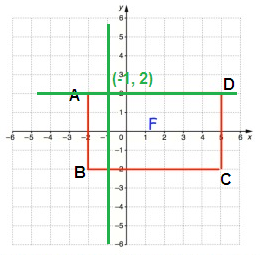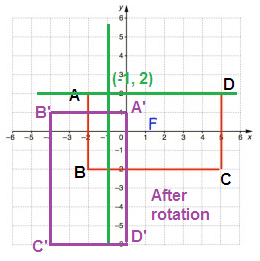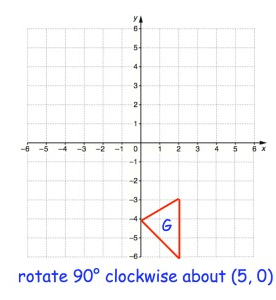EXAMPLES OF ROTATION OF 2D SHAPES WHEN CENTER OF ROTATION IS GIVEN
If we rotate the 2d shape about origin, we will follow the rules given below about the angle that we are rotating.
Step 1 :
If center of rotation is something else than origin, we have to draw the horizontal and vertical lines in order to consider we have origin at the specified point.
Step 2 :
From the center of rotation, we have to move horizontally and vertically to get each vertices of the 2d shape.
Step 3 :
Moving right, x-coordinate = positive
Moving left, x-coordinate = negative
Moving up, y-coordinate = positive
Moving down, y-coordinate = negative
Rotating the shape means moving them around a fixed point. There are two directions
i) Clockwise
ii) Counter clockwise (or) Anti clockwise
The shape itself stays exactly the same, but its position in the space will change.
|
90° clockwise 90° counter clockwise 180° 270° clockwise 270° counter clockwise |
(x, y) ==> (y, -x) (x, y) ==> (-y, x) (x, y) ==> (-x, -y) (x, y) ==> (-y, x) (x, y) ==> (y, -x) |
Rotate each of the shapes below as instructed, using the origin, (0, 0), as the centre of rotation.
Problem 1 :

Solution:

Point A :
From P, move 2 unit right and 2 unit up. So, A(2, 2).
Point B :
From P, move 2 unit right and 1 unit up. So, B(2, 1)
Point C :
From P, 5 unit right and 1 unit up. So, C(5, 1)
Point D :
From P, 5 unit right and 2 unit up. So, D(5, 2)
Rule for 180° rotation
(x, y) ==> (-x, -y)
|
A(2, 2) B(2, 1) C(5, 1) D(5, 2) |
A'(-2, -2) B'(-2, -1) C'(-5, -1) D'(-5, -2) |

Problem 2 :

Solution:

Point A:
From P, move 3 units left and 2 units down. So, A(-3, -2)
Point B:
From P, move 1 unit left and 2 units down. So, B(-1, -2)
Point C:
From P, move 1 unit left and 5 units down. So, C(-1, -5)
Rule for 90° clockwise rotation
(x, y) ==> (y, -x)
|
A(-3, -2) B(-1, -2) C(-1, -5) |
A'(-2, 3) B'(-2, 1) C'(-5, 1) |

Problem 3 :

Solution:

Point A:
From P, move 1 unit right and no vertical move. So, A(1, 0)
Point B:
From P, move 3 units right and 2 units down. So, B(3, 2)
Point C:
From P, move 5 units right and no vertical move. So, C(5, 0)
Rule for 90° anticlockwise rotation
(x, y) ==> (-y, x)
|
A(1, 0) B(3, 2) C(5, 0) |
A'(0, 1) B'(-2, 3) C'(0, 5) |

Problem 4 :

Solution:

Point A:
From P, move 4 units left and no vertical move. So, A(-1, 0)
Point B:
From P, move 1 unit left and 4 units down. So, B(-1, -4)
Point C:
From P, move 6 units right and 4 units down. So, C(6, -4)
Point D:
From P, move 6 units right and no vertical move. So, D(6, 0)
Rule for 90° clockwise rotation
(x, y) ==> (y, -x)
|
A(-1, 0) B(-1, -4) C(6, -4) D(6, 0) |
A'(0, 1) B'(-4, 1) C'(-4, -6) D'(0, -6) |

Problem 5 :

Solution:

Point A:
From P, move 5 units left and 4 units down. So, A(-5, -4)
Point B:
From P, move 3 units left and 3 units down. So, B(-3, -3)
Point C:
From P, move 3 units left and 6 units down. So, C(-3, -6)
Rule for 90° clockwise rotation
(x, y) ==> (y, -x)
|
A(-5, -4) B(-3, -3) C(-3, -6) |
A'(-4, 5) B'(-3, 3) C'(-6, 3) |

Recent Articles
-
Finding Range of Values Inequality Problems
May 21, 24 08:51 PM
Finding Range of Values Inequality Problems -
Solving Two Step Inequality Word Problems
May 21, 24 08:51 AM
Solving Two Step Inequality Word Problems -
Exponential Function Context and Data Modeling
May 20, 24 10:45 PM
Exponential Function Context and Data Modeling